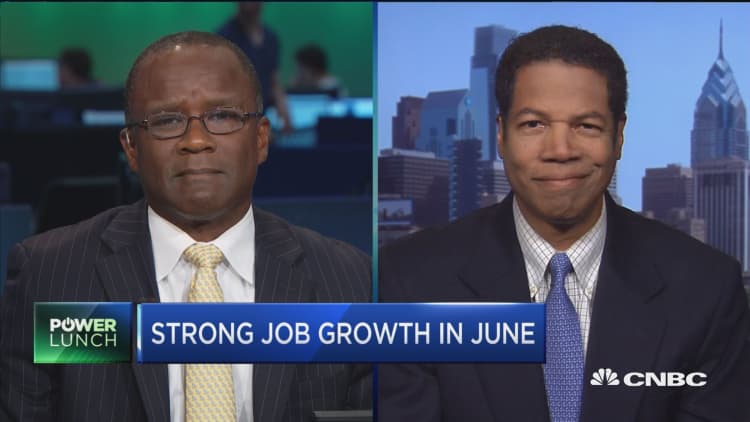The June jobs report brought with it almost universally good news, unless you're a worker looking for a substantially fatter paycheck.
Wage gains remain positive but muted, growing at 2.7 percent annually, or pretty much the same level as the previous three months and below Wall Street expectations. That's despite the supposed benefits of a tightening labor market, and a tax cut that was supposed to push average hourly earnings over the 3 percent barrier.
Job gains —213,000 in all for nonfarm payrolls — were spread across the board but the positions are paying only a bit more due to a variety of factors that are keeping gains just above inflation.
"You're creating jobs in good areas where you're creating careers — manufacturing, business services, health care construction, those are places you want to see the jobs created. But the conundrum of wages continues," said JJ Kinahan, chief market strategist at TD Ameritrade. "How are we not getting higher wages? A lot of that has to do with the fact that at lower end of the scale you're seeing people being replaced by machines. There are jobs, but there's a lot of lateral movement."
Indeed, there were 6.7 million job openings as of the most recent count and 6.6 million people who the Bureau of Labor Statistics considers unemployed.
That should be creating more substantial wage pressures. Yet the jobs market keeps showing each month that there's more slack than economists are figuring and thus more room for employers to keep pay increases modest.
In June specifically, the entrance of 601,000 workers either back into the labor force or entering for the first time helped overall job gains while keeping wages lower. The growth of the labor force participation rate accounted for an increase in the unemployment rate to 4 percent from 3.8 percent, a statistical change that actually showed more vibrant conditions.
"While the wage growth rate didn’t increase this month, having it hold steady is a good sign," said Cathy Barrera, chief economist at ZipRecruiter, an online employment marketplace. "The increased labor force participation could create slack in the labor market if there isn’t enough demand for those workers. In this case, wage growth may be dampened. That the rate did not decline further indicates that these workers are alleviating a shortage rather than creating slack."

Moreover, Barrera said a surge in youth and those without college educations into the labor market also is holding back wage pressures.
From a market perspective, investors care about wages because they impact inflation which in turn can influence interest rates.
Federal Reserve officials have joined other economists in expressing concern over the so-called skills gap in the marketplace, the dynamic that is causing jobs to go unfilled and wage pressures to be muted because employers are struggling to find workers with the right qualifications.
On the other side of that equation, though, are workers who say that if companies paid more there would be a greater response from potential employees.
The Fed's job is to decide whether conditions remain conducive to plans to increase rates two more times this year, or to wait for more signs of wage inflation. Central bank officials generally believe Fed policy works on a lag, meaning they don't to wait until it's too late before moving.
"While this is unquestionably a positive report, it won’t make the Fed’s job any easier," said Ron Temple, head of U.S. equities and co-head of multiasset at Lazard Asset Management. "The doves will focus on workers rejoining the labor force and on muted wage growth. The hawks will zero in on the fact that the US has added 215,000 jobs per month in 2018, nine years into the growth cycle.”
The issue about modest wage gains ultimately could begin to change longer-run expectations, a danger the Fed is trying to avoid. Economists believe inflation can be a self-fulfilling cycle in either direction, and the prolonged period of low pressures has caught the attention of policymakers.
"They’re worried we’re breaking down some of the mechanisms that used to be at work in the wage inflation dynamic," said Diane Swonk, chief economist at Grant Thornton. "In Japan, the idea is that with deflation and very low inflation, no one expected raises and they began to erode wages. Part of the stagflation is that they actually lost living standards."


